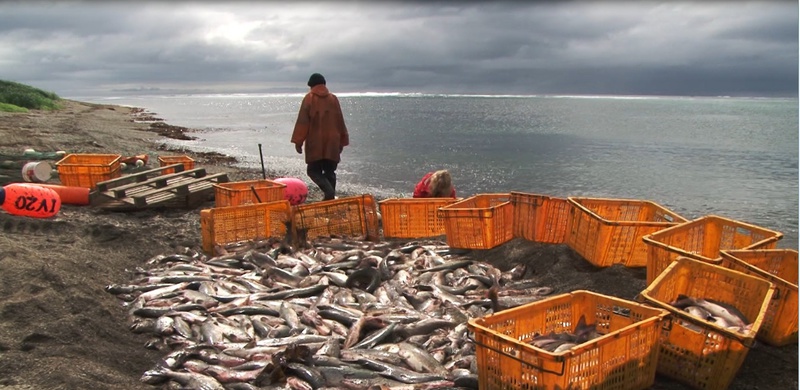Thoughts about Xenos and Kamtchatka March 19, 2015
"Xenos" is a film with somewhat unstable camerawork but with very clear message and image. It's power is in it's brevity. Background sound consists of clips from all the phone calls between the immigrants themselves and with their families back home. The camera holder clearly has an insider position - autoethnography is, with the support of technological developments, becoming more an increasingly extensive form of documentary.The topic of immigration in “Xenos”extends from the individual level to deep generalisations. Provided, however, that the viewer does not empathise exclusively with the characters, but maintains some distance and thinks about what could be done differently. What would be the alternative to immigration? How are purely physical disturbance factors such as war and fear of death mixed with cultural myths? How much is the escape to another country an adventure and how much the echo of ancient stories of heroes who had to go out into the wide world to seek happiness?
Young Palestinians, stuck in Greece, have not entered the Promised Land but a place that can rather be characterised as purgatory. However, unlike purgatory, Greece - struggling with social crisis - does not provide hope or an effective plan for the future. The goals and objectives are lost. Young men who jumped out of the frying pan into the fire admit that they have to take drugs on a daily basis in order to survive. To get the money for drugs they have to stoop low and sell their bodies to men or old women.
During a phone call home one of the character's mother tells him, "Find a woman and get married!" His father demands: "Go to work!" But for these youngsters it is not so easy to find work in Greece, and beautiful young women are not exactly available either. In this detail lies the core essence of the film, which the director himself probably did not realise. This is an explosion that fractures the entire image of immigration. Mum and dad consider finding work and getting married natural and do-able, but the situation is much better at home, and being away becomes emphatically meaningless.
Thus, a large part of the immigration narrative is an ancient myth and simple ecology - a mass of people moving thoguhtlessly towards a greater concentration of resources. Not taking into account the fact that a new and different environment requiers increased activity to adapt and often the environment itself is not the most welcoming and ready to offer the chance. The question is one of having a common cultural background, which tends to promote the desire for smart phones, rather than an entrepreneurial will to adapt or patriotism for one's homeland. The key frame of "Xenose" – a quote from Aristotle written in English to the wall of a house in Athens – reflects the face of the media throughout the 21st century. Arab adolescents discuss what it might mean but conclude only that the text is in English.
Finally there is also an opposition between spatial and mental escape. You bring yourself inevitably with you anywhere you go and the change in surrounding space offers only a limited change. There are few who know how to use it to their advantage. Do what you want, even Islam will fail when giving the human soul a great personal narrative becomes a necessity.
Still from Xenos
Julia Mironova's "Kamchatka" goes deeply into the topic of personal life goals. It is a portrait of middle-aged Vjatšestlav Nemõšev, who has for many years participated in the war in Chechnya (in which roles or how militarily is not spesifically brought out in the film).
Nemõšev's personality is a blend of a cultural character and a modern macho man that can conjure up a distant echo from Hemingway to superstar Putin. This war veteran, tempered/traumatised in the masculine world, is looking for an alternative, and for peace. To find it, he travels to Kamchatka to the Commander Islands accompanied by his beautiful young girlfriend. As the holiday does not have a mission in itself, the protagonist finds himself colliding with this peculiar vacuum, unable to find engaging activities and give meaning to life. Sarcasm and seriousness are deeply mixed in his praise of the island's life and weather conditions. Alowing the spirit of autoethnography to take over, Nemõšev devotes a large part of the time to filming nature scenes. To the viewer, however, there is no clear distinction between Nemõšev's shots and clips filmed by someone else. It is also unclear how much is actually directed by Julia Mironova and how much is influenced by her contribution or presence.
The island's enviroment is projected to us as a larger system without focusing on specific ethnographic questions. However, fragment by fragment natural images open up to us and we get fleeting glances of people and animals on the island. Close up shots of fur seals and salmon fisheries work both as purely physical magnets and as the core of a meaningful central idea.
Although Nemõšev's story has no clear beginning or end, remaining somewhat fragmented and sprawling, it offers a completely immersive viewing experience. Towards the end this kind of structure feels increasingly justified, leaving loose ends as the symbol of being unconnected in the modern world. Addiction is a disease of Western civilisation, wrote Jaan Kaplinski in the 70s. At the most general level is the addiction of rhythm. For some this is manifested in chemical substances, for others in alarming memory images. People tend to look for solutions from outside, forgetting to look inside themselves, an oversight that is often a dead end.
Still from Kamtchatka - the cure for hatred
.jpg)
